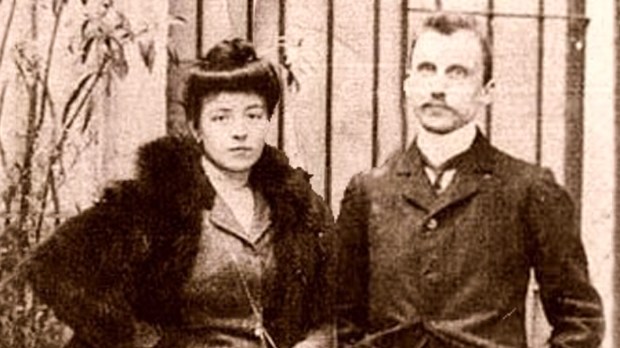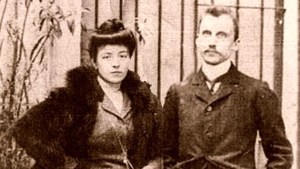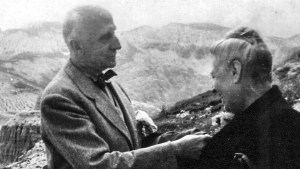Luigi and Maria Beltrame Quattrocchi, the first non-martyr married couple to be beatified, demonstrate through their intense and abundant correspondence how deep and incarnate their love was.
Fr. Pascal Ide, who wrote a book in French on holy couples (“Sacrés couples!”), admits to being amazed by the discovery of this couple’s unique bond.
“We sort of have an image of a holy couple like two monks in robes, each living at one end of the house, and putting all their energy into devoting themselves to good works! But the lives and abundant correspondence [of the Quattrocchis] show their love in a concrete way,” he told Aleteia.
The letters of the Quattrocchi couple, whom Pope John Paul II beatified in 2001, “are full of that erotic love, eros, still inflamed with desire.”
This eros isn’t limited to simple sexual attraction, insofar as it is part of a whole. The erotic dimension is an integral part of Christian marriage, just like the philia and agape kinds of love.
Fr. Stéphane Seminckx, an expert on the encyclical Humanae Vitae, uses the metaphor of Russian dolls to illustrate these three dimensions of love:
- The love of attraction (eros) makes us say: “I perceive you as something good for me.” It’s a self-interested love, which responds to a need (to be attracted to the other in order to love them). It has a carnal connotation and is a source of pleasure.
- The love of friendship (philia) includes and transcends the first one and makes us say: “I perceive you as a person: I seek your good.” It is a disinterested love, which responds to the need to get out of oneself. It has a spiritual connotation and is a source of joy.
- Finally, conjugal love (agape), which encompasses the two previous dimensions, makes us say: “I give myself to you.” It is a total gift. It is a response to a vocation, and is a source of happiness.
Let us return to this incarnated love, so present in the correspondence of the holy spouses Luigi and Beltrame Quattrocchi.
The use of English, a gesture of modesty
In many of their letters, especially those exchanged when they were engaged in 1905, Luigi and Maria — who were Italian and usually communicated in their native tongue —spontaneously expressed themselves in English when the formulation of their feelings seemed too bold.
“I take your hands and put them on my face, on my heart, on my mouth and I kiss them a million times,” Maria wrote. Also: “I love you, I adore you, and that’s all; no that is not all, because to complete the sentence, I must add that you love me. Now it is all.“
Symbolic gestures
Maria and Luigi are very creative in the way they express their love. “They don’t stick to verbal language,” says Fr. Ide, “but they willingly use gestures, in a way that is both concrete and modest.” For example, this letter of Maria to Luigi is expressive: “My holy love, come, come and take refuge in me; I will welcome you in my arms, I will hold you on my knees, I will caress you in such a way, my love, that you will be soothed without delay.”
They even put a kiss on the paper, so that the other can receive it upon reading the letter. Luigi writes, “I have put a kiss so warm as my love: the thought that you shall take it with your adored lips gives me a moment of happiness.” Maria replies, “Here I put my most ardent kiss for you.“
A vital need
Their love for each other is a vital need. They don’t hesitate to use metaphors evoking physiological needs to express the lack created by the absence of the other, or simply of their letters. “My soul needs your soul to live,” Maria writes to Luigi. Luigi responds in the same vein: “Only your love can give me the force of living.“
More prosaically, they measure their love by the “hunger” it provokes: “I waited for the consolation of one of your letters like a poor starving person desires a mouthful of bread” (Letter to Luigi). And even after 17 years of marriage, Maria writes, “This is enough for today. Yesterday’s letter will serve as food for today’s, even if it’s empty and stupid.”
They also use the image of thirst: “My beautiful love, I thank you infinitely for the good that you did for my soul and I wish you could drink my entire soul through the ardent kiss that I put here for you” (Letter to Luigi). And “I am always so thirsty for your words and they do so much good to my soul” (Letter to Maria).
The power of memories
Recalling pleasant memories is also a way to fan the flame of love. Luigi thus describes a day when he wished to kiss his bride:
“What did happen the nineteenth of July? And how shall I be able to forget that moment of divine happenings. You perhaps did not feel, but I was trembling for the emotion: and I told you, afterwards, that I would have kissed you on the mouth, but that I had not dared: if I should have put my lips on yours, I should have drunk your soul, and you should have drunk mine.“



